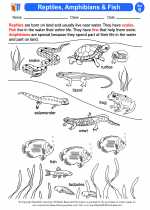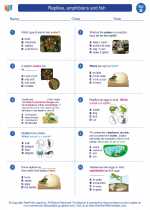Reptiles, amphibians and fish -> ferns
Ferns
Ferns are a group of non-flowering, vascular plants that reproduce via spores. They are found in various environments including moist forests, swamps, and grasslands. Ferns have a unique life cycle and distinctive features that set them apart from other plants.
Life Cycle of Ferns
Ferns have a life cycle that includes two distinct stages: the sporophyte stage and the gametophyte stage.
- Sporophyte Stage: This is the dominant stage of the fern's life cycle. It begins with a spore, which develops into a small, heart-shaped structure called a prothallus. The prothallus produces male and female reproductive structures called antheridia and archegonia, respectively. These structures release sperm and eggs, which fuse to form a zygote.
- Gametophyte Stage: The zygote grows into a new sporophyte plant, completing the cycle.
Distinctive Features of Ferns
Ferns have several distinctive features that set them apart from other plants:
- Fronds: Fern leaves are called fronds and are usually divided into smaller leaflets. They can vary in size and shape, and may be simple or highly compound.
- Sori: These are clusters of sporangia (structures that produce and contain spores) found on the undersides of fern fronds. When the spores are mature, the sporangia burst open, releasing the spores for reproduction.
- Vascular Tissue: Ferns have vascular tissue that allows them to transport water and nutrients throughout the plant, enabling them to grow larger than non-vascular plants.
Study Guide
- What are the two distinct stages of the fern's life cycle? Describe each stage.
- What are the male and female reproductive structures in the gametophyte stage of ferns?
- What are the clusters of sporangia found on the undersides of fern fronds called?
- Explain the function of vascular tissue in ferns.
- Identify and describe the distinctive features of fern leaves.
◂Science Worksheets and Study Guides Second Grade. Reptiles, amphibians and fish
Study Guide Reptiles, amphibians and fish
Reptiles, amphibians and fish  Activity Lesson
Activity Lesson Reptiles, Amphibians & Fish
Reptiles, Amphibians & Fish  Worksheet/Answer key
Worksheet/Answer key Reptiles, amphibians and fish
Reptiles, amphibians and fish  Worksheet/Answer key
Worksheet/Answer key Reptiles, amphibians and fish
Reptiles, amphibians and fish  Worksheet/Answer key
Worksheet/Answer key Reptiles, amphibians and fish
Reptiles, amphibians and fish  Worksheet/Answer key
Worksheet/Answer key Reptiles, Amphibians and Fish
Reptiles, Amphibians and Fish  Vocabulary/Answer key
Vocabulary/Answer key Reptiles, amphibians and fish
Reptiles, amphibians and fish 

 Activity Lesson
Activity Lesson
 Worksheet/Answer key
Worksheet/Answer key
 Worksheet/Answer key
Worksheet/Answer key
 Worksheet/Answer key
Worksheet/Answer key
 Worksheet/Answer key
Worksheet/Answer key
 Vocabulary/Answer key
Vocabulary/Answer key

The resources above cover the following skills:
LIFE SCIENCE (NGSS)
Ecosystems: Interactions, Energy, and Dynamics
Students who demonstrate understanding can:
Plan and conduct an investigation to determine if plants need sunlight and water to grow.